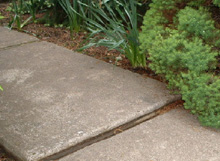 It’s easy to discuss thermal expansion in terms of students’ experience. They see expansion slats in sidewalks all the time. They may have noticed highway bridge expansion joints (and if they haven’t, they will probably be able to see one within 24 hours if they’re observant). Evidence for the existence of thermal expansion abounds.
It’s easy to discuss thermal expansion in terms of students’ experience. They see expansion slats in sidewalks all the time. They may have noticed highway bridge expansion joints (and if they haven’t, they will probably be able to see one within 24 hours if they’re observant). Evidence for the existence of thermal expansion abounds.However, creating measurable expansion in the classroom is a challenge. The coefficient of linear expansion for virtually all materials is on the order of 10-5 K-1. So even with a temperature increase of 100 K, an object will expand by about 0.1% of its length.
I can think of three experimental ways to create a reasonable thermal expansion demonstration:
1. Create an enormous temperature increase. Not practical, though, because even a 1000 K temperature change only causes a 1% length expansion.
2. Use a very, very long object, so that the 0.1% increase is big enough to see. Well, if you heat a 10 m long rod by 100 K, it will expand by about a centimeter. I don’t know about you, but I don’t have a 10 m rod handy, nor do I have room for it in my classroom, nor do I have a way of heating it relatively uniformly. Ugh.
3. Get a measuring device that can measure itty bitty length changes.
 I’ve gotten method number 3 to work in my classroom. Yesterday I used one of those metal rings with a wooden handle that come with commercial thermal expansion kits. I used a micrometer (pictured), which has can measure plus or minus 5 thousandths of a millimeter, to measure the WIDTH of the ring. You see, linear expansion happens in all directions. The width of, say, a rod will expand by the same percentage as will the length. I choose to measure the width of the ring because my micrometer can measure that easily.
I’ve gotten method number 3 to work in my classroom. Yesterday I used one of those metal rings with a wooden handle that come with commercial thermal expansion kits. I used a micrometer (pictured), which has can measure plus or minus 5 thousandths of a millimeter, to measure the WIDTH of the ring. You see, linear expansion happens in all directions. The width of, say, a rod will expand by the same percentage as will the length. I choose to measure the width of the ring because my micrometer can measure that easily. The width at room temperature was 4.30 mm. I heated the ring for a minute or two in a Bunsen burner. I used an infrared non-contact thermometer – pictured to the right, available for no more than $30 – to find that the ring’s temperature rose to about 220 degrees Celsius, an increase of about 200 degrees over room temperature. Thus, an order of magnitude estimate of the ring’s expansion is that ΔL/L = (10-5)(200) = 0.2%. Since I don’t know what my ring is made of, I can merely guess that the expansion should be in the neighborhood of a few tenths of a percent. I measured a new length of 4.33 mm, an increase of about 0.7%, which works for me.
The width at room temperature was 4.30 mm. I heated the ring for a minute or two in a Bunsen burner. I used an infrared non-contact thermometer – pictured to the right, available for no more than $30 – to find that the ring’s temperature rose to about 220 degrees Celsius, an increase of about 200 degrees over room temperature. Thus, an order of magnitude estimate of the ring’s expansion is that ΔL/L = (10-5)(200) = 0.2%. Since I don’t know what my ring is made of, I can merely guess that the expansion should be in the neighborhood of a few tenths of a percent. I measured a new length of 4.33 mm, an increase of about 0.7%, which works for me. 
Tidak ada komentar:
Posting Komentar